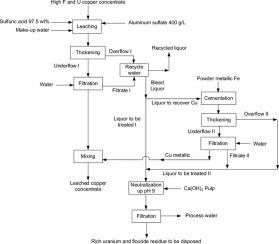Minerals Engineering ( IF 4.8 ) Pub Date : 2021-06-25 , DOI: 10.1016/j.mineng.2021.107039 Ruberlan Silva , Danielly Couto , Aline Tavares , Lorena Guimarães

|
The main Cu-bearing mineral in copper concentrates consumed in smelters around the world is chalcopyrite (CuFeS2). Minor participation in this consumption is copper concentrates containing secondary copper minerals, such as chalcocite (Cu2S) and bornite (Cu5FeS4). The main issues concerning these copper concentrates are the amount of impurities, such as, fluoride and uranium. These impurities cause a lot of problems for smelters owners, such as equipment corrosion, gas treatment necessity and radionuclides residues generation, leading them to impose restrictions to buy fluoride and uranium copper concentrates. This study proposes a selective atmospheric sulfuric acid leaching process route to extract the maximum of fluoride and uranium and a minimum of copper from two types of copper concentrates, one having chalcocite/bornite as main Cu-bearing minerals, named as chalcocite/bornite concentrate, and another with chalcopyrite as the main Cu-bearing mineral, named as chalcopyrite concentrate. The results show that it is possible to reduce significantly the amount of fluoride and uranium in both samples. These two samples required the addition of sulfuric acid until reaching a pH of (3.5 ± 0.2), which means consumption of 23 kg and 9 kg of H2SO4 97.5 wt% per ton of chalcocite/bornite concentrate or chalcopyrite concentrate, respectively. The addition of aluminum sulfate increases the fluoride extraction, whereas it did not raise the uranium extraction. Chalcocite/bornite concentrate showed a slow kinetic to have fluoride leached, whereas chalcopyrite concentrate presented a fast kinetic to have uranium leached. It was possible to extract 60% of fluoride and 35% of uranium from chalcocite/bornite concentrate and around 10% of fluoride and 60% of uranium from chalcopyrite concentrate. As expected, the copper leached from chalcocite/bornite concentrate was higher (~4.5% of total Cu) than from chalcopyrite concentrate (~0.3% of total Cu). Moreover, it was proposed a complete process route to reduce the amount of fluoride and uranium comprising of acid leaching, copper recovery from the liquor by cementation with powder Fe and liquor treatment by raising the pH up to 9.0 by addition of calcium hydroxide pulp.
中文翻译:

选择性硫酸浸出铜浓缩物中氟和铀的强化工艺路线
世界各地冶炼厂消耗的铜精矿中的主要含铜矿物是黄铜矿 (CuFeS 2 )。少量参与这种消耗的是含有次生铜矿物的铜精矿,如辉铜矿 (Cu 2 S) 和斑铜矿 (Cu 5 FeS 4)。这些铜精矿的主要问题是杂质的数量,例如氟化物和铀。这些杂质给冶炼厂业主带来了很多问题,例如设备腐蚀、气体处理的必要性和放射性核素残留物的产生,导致他们限制购买氟化物和铀铜精矿。本研究提出了一种选择性常压硫酸浸出工艺路线,从两种铜精矿中提取最多的氟化物和铀,最少的铜,一种以辉铜矿/斑铜矿为主要含铜矿物,称为辉铜矿/斑铜矿精矿,另一种以黄铜矿为主要含铜矿物,命名为黄铜矿精矿。结果表明,可以显着降低两个样品中氟化物和铀的含量。2 SO 4每吨黄铜矿/斑铜矿精矿或黄铜矿精矿分别为 97.5 wt%。硫酸铝的加入增加了氟化物的提取,而它没有提高铀的提取。黄铜矿/斑铜矿精矿表现出缓慢的氟化物浸出动力学,而黄铜矿精矿表现出快速浸出铀的动力学。可以从辉铜矿/斑铜矿精矿中提取 60% 的氟化物和 35% 的铀,从黄铜矿精矿中提取大约 10% 的氟化物和 60% 的铀。正如预期的那样,从黄铜矿/斑铜矿精矿中浸出的铜(占总铜的约 4.5%)高于从黄铜矿精矿中浸出的铜(占总铜的约 0.3%)。此外,提出了一种完整的工艺路线来减少氟化物和铀的用量,包括酸浸,

























 京公网安备 11010802027423号
京公网安备 11010802027423号